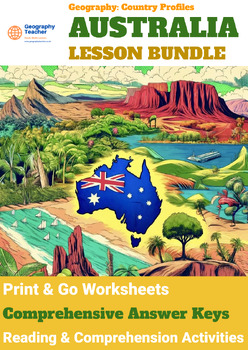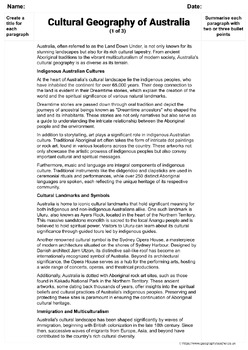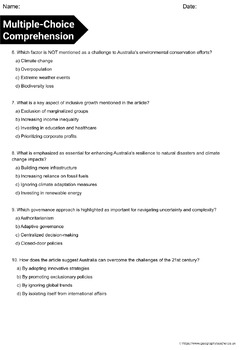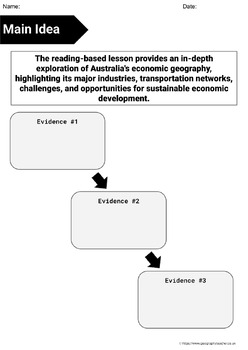Australia Country Study (9-Lesson Geography Bundle)
- Zip
Products in this Bundle (9)
showing 1-5 of 9 products
Bonus
Description
Unmissable 30% discount when you purchase all 9 lessons!
*INCLUDES SPECIAL BONUS TEMPLATE PACK FREE-OF-CHARGE*
This is a great-value lesson bundle of 9 flexible reading comprehension-based lessons based on the 'Australia: Country Study' geography scheme of work.
When studying the Geography syllabus "Australia Country Profile Bundle," students will embark on a comprehensive exploration of Australia's diverse geographical, cultural, political, economic, environmental, and historical landscape.
In Lesson 1, students will gain a foundational understanding of Australia's location on a map and its continent-island status, along with analyzing population distribution patterns and factors influencing density. Subsequent lessons delve deeper into Australia's physical geography, including its major features like the Great Dividing Range and the Murray-Darling Basin, as well as its climate patterns and their impact on human activities.
Moving to Lesson 3, students explore human geography, examining population distribution trends, cultural diversity, and economic activities across different regions. Lesson 4 focuses on political geography, covering the political divisions of Australia, its governmental structure, and electoral systems. Economic geography is the focus of Lesson 5, where students identify major industries, transportation networks, and economic challenges.
Lesson 6 addresses environmental issues, analyzing causes and consequences of degradation and efforts to address challenges sustainably. Cultural geography, in Lesson 7, explores landmarks, indigenous cultures, and multicultural influences on Australian society. Lastly, Lesson 8 delves into historical geography, examining significant events, migration patterns, and territorial changes that have shaped Australia's past.
The culminating lesson, Lesson 9, projects into the future, identifying emerging trends and challenges like demographic changes and technological advancements, while discussing strategies for sustainable development and addressing global dynamics. Through these lessons, students not only gain knowledge about Australia's geography but also develop critical thinking, analytical skills, and a deeper understanding of global issues and their interconnectedness.
Student focus:
Lesson 1: Introduction to Australia
- Identify the location of Australia on a map and describe its relative position to other countries and bodies of water.
- Describe the geographical features of Australia, including its continent-island status, diverse landscapes, and major deserts.
- Analyze population distribution patterns within Australia and discuss factors influencing population density.
Lesson 2: Physical Geography of Australia
- Identify and describe the major physical features of Australia, such as the Great Dividing Range, Uluru, and Murray-Darling Basin.
- Explain the significance of major rivers and bodies of water, including the Murray River, Lake Eyre, and Great Barrier Reef.
- Analyze climate patterns across different regions of Australia and discuss their impact on human activities and ecosystems.
Lesson 3: Human Geography of Australia
- Analyze population distribution trends within Australia, including urban areas, rural settlements, and demographic shifts.
- Explore cultural diversity within Australia, including indigenous cultures, immigrant communities, and multiculturalism.
- Investigate patterns of economic activity and development across different regions of Australia, including industry, agriculture, and services.
Lesson 4: Political Geography of Australia
- Identify the political divisions of Australia, including states, territories, and capital cities.
- Explain the structure of the Australian government, including the federal system, parliamentary democracy, and roles of the Prime Minister and Governor-General.
- Analyze the electoral system and process in Australia, including federal elections, state elections, and voting rights.
Lesson 5: Economic Geography of Australia
- Identify major industries and economic activities in Australia, such as mining, agriculture, tourism, and finance.
- Explain the role of transportation networks, including roads, railways, and ports, in facilitating trade and economic development.
- Analyze economic challenges and opportunities facing Australia, including globalization, resource dependency, and regional disparities.
Lesson 6: Environmental Issues in Australia
- Identify major environmental issues in Australia, such as drought, bushfires, deforestation, and habitat destruction.
- Explain the causes and consequences of environmental degradation, including human activities, land use change, and natural disasters.
- Explore efforts to address environmental challenges in Australia, including conservation initiatives, environmental policies, and sustainable development strategies.
Lesson 7: Cultural Geography of Australia
- Identify cultural landmarks and symbols associated with Australia, such as Uluru, Sydney Opera House, and Aboriginal rock art sites.
- Explore indigenous Australian cultures, including Dreamtime stories, art, music, and languages.
- Analyze the influence of immigration and multiculturalism on Australian society, including cultural diversity, food, festivals, and the arts.
Lesson 8: Historical Geography of Australia
- Analyze major events and turning points in Australian history, including indigenous cultures, British colonization, and federation.
- Explore patterns of migration and immigration that have shaped the demographic and cultural landscape of Australia, including British settlement, convict transportation, and post-war immigration.
- Investigate territorial changes and border dynamics in Australian history, including land dispossession, treaty negotiations, and reconciliation efforts.
Lesson 9: Future Challenges and Opportunities
- Identify emerging trends and issues shaping the future of Australia, including demographic changes, technological advancements, and international relations.
- Analyze the opportunities and challenges posed by globalization, including economic integration, cultural exchange, and geopolitical dynamics.
- Discuss strategies for addressing future challenges and promoting sustainable development in Australia, including innovation, collaboration, and policy solutions.
----------------------------------------------------------------------------------------------
We offer a FREE product in this format which we encourage you to download, to see if it works for you and your students. This product - The Impact Of Conflict And Displacement On Food Security In Syria- can be downloaded for free here.
----------------------------------------------------------------------------------------------
This resource is perfect for the classroom, distance-learning, homework, exam preparation and home-schooling.
This is a quality, ready-made resource intended for busy teachers, cover teachers, parents and home-schoolers to simply print and go. Each individual resource is packed with a variety of differentiated comprehension activities for students, including 'stretch & challenge tasks' and further recommended classroom, project and homework activities. Each resource also includes a detailed lesson plan, for a 60-minute lesson, based around the reading passage. This provides incredible flexibility for the teacher to transform this resource into a comprehensive, student-centred lesson, which encourages independent and team learning activities. The resource also provides a variety of templates for teachers to carry out Assessment For Learning (AFL) to identify independent student and whole class progress.
Best of all, each individual lesson includes a comprehensive answer key, making teachers' lives far more simple! It also means some students can self-assess or peer-assess their work.
Each Reading Comprehension Learning Resource Includes The Following:
- Reading Passage
- Multiple-Choice Questions
- Plenary: True / False Activities
- Main Idea/Key Details Graphic Organizer
- Who, What, Where, When Graphic Organizer
- Writing Framework For Students
- Standard-Level Comprehension
- Intermediate-Level Comprehension
- Advanced-Level Comprehension
- Stretch & Challenge Questions
- Further Recommended Activities For Teacher And Students
- Detailed 60-Minute Lesson Plan, Based On Article, For Teachers
- Student Summary Worksheets: Lesson Summary, Head Heart Hashtag, Exit Ticket, Progress Pyramid, Planning For Progress
- Student Answer Templates





